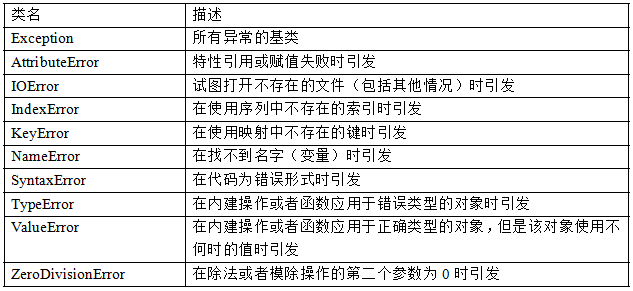python异常
python用异常对象(exception object)来表示异常情况。遇到错误后,会引发异常。如果异常对象并未被处理或捕捉,程序就会用所谓的 回溯(Traceback, 一种错误信息)终止执行:
>>> 1/0 Traceback (most recent call last): File "<pyshell#0>", line 1, in <module> 1/0 ZeroDivisionError: integer division or modulo by zero
raise 语句
为了引发异常,可以使用一个类(Exception的子类)或者实例参数数调用raise 语句。下面的例子使用内建的Exception异常类:
>>> raise Exception #引发一个没有任何错误信息的普通异常 Traceback (most recent call last): File "<pyshell#1>", line 1, in <module> raise Exception Exception >>> raise Exception('hyperdrive overload') # 添加了一些异常错误信息 Traceback (most recent call last): File "<pyshell#2>", line 1, in <module> raise Exception('hyperdrive overload') Exception: hyperdrive overload
系统自带的内建异常类:
>>> import exceptions >>> dir(exceptions) ['ArithmeticError', 'AssertionError', 'AttributeError', 'BaseException', 'BufferError', 'BytesWarning', 'DeprecationWarning', 'EOFError', 'EnvironmentError', 'Exception', 'FloatingPointError', 'FutureWarning', 'GeneratorExit', 'IOError', 'ImportError', 'ImportWarning', 'IndentationError', 'IndexError', 'KeyError', 'KeyboardInterrupt', 'LookupError', 'MemoryError', 'NameError', 'NotImplementedError', 'OSError', 'OverflowError', 'PendingDeprecationWarning', 'ReferenceError', 'RuntimeError', 'RuntimeWarning', 'StandardError', 'StopIteration', 'SyntaxError', 'SyntaxWarning', 'SystemError', 'SystemExit', 'TabError', 'TypeError', 'UnboundLocalError', 'UnicodeDecodeError', 'UnicodeEncodeError', 'UnicodeError', 'UnicodeTranslateError', 'UnicodeWarning', 'UserWarning', 'ValueError', 'Warning', 'WindowsError', 'ZeroDivisionError', '__doc__', '__name__', '__package__']
哇!好多,常用的内建异常类:

自定义异常
尽管内建的异常类已经包括了大部分的情况,而且对于很多要求都已经足够了,但有些时候还是需要创建自己的异常类。
和常见其它类一样----只是要确保从Exception类继承,不管直接继承还是间接继承。像下面这样:
>>> class someCustomExcetion(Exception):pass
当然,也可以为这个类添加一些方法。
捕捉异常
我们可以使用 try/except 来实现异常的捕捉处理。
假设创建了一个让用户输入两个数,然后进行相除的程序:
x = input('Enter the first number: ') y = input('Enter the second number: ') print x/y #运行并且输入 Enter the first number: 10 Enter the second number: 0 Traceback (most recent call last): File "I:/Python27/yichang", line 3, in <module> print x/y ZeroDivisionError: integer division or modulo by zero
为了捕捉异常并做出一些错误处理,可以这样写:
try: x = input('Enter the first number: ') y = input('Enter the second number: ') print x/y except ZeroDivisionError: print "输入的数字不能为0!" #再来云行 >>> Enter the first number: 10 Enter the second number: 0 输入的数字不能为0! #怎么样?这次已经友好的多了
假如,我们在调试的时候引发异常会好些,如果在与用户的进行交互的过程中又是不希望用户看到异常信息的。那如何开启/关闭 “屏蔽”机制?
class MuffledCalulator: muffled = False #这里默认关闭屏蔽 def calc(self,expr): try: return eval(expr) except ZeroDivisionError: if self.muffled: print 'Divsion by zero is illagal' else: raise #运行程序: >>> calculator = MuffledCalulator() >>> calculator.calc('10/2') 5 >>> calculator.clac('10/0') Traceback (most recent call last): File "<pyshell#30>", line 1, in <module> calculator.clac('10/0') AttributeError: MuffledCalulator instance has no attribute 'clac' #异常信息被输出了 >>> calculator.muffled = True #现在打开屏蔽 >>> calculator.calc('10/0') Divsion by zero is illagal
多个except 子句
如果运行上面的(输入两个数,求除法)程序,输入面的内容,就会产生另外一个异常:
try: x = input('Enter the first number: ') y = input('Enter the second number: ') print x/y except ZeroDivisionError: print "输入的数字不能为0!" #运行输入: >>> Enter the first number: 10 Enter the second number: 'hello.word' #输入非数字 Traceback (most recent call last): File "I:\Python27\yichang", line 4, in <module> print x/y TypeError: unsupported operand type(s) for /: 'int' and 'str' #又报出了别的异常信息
好吧!我们可以再加个异常的处理来处理这种情况:
try: x = input('Enter the first number: ') y = input('Enter the second number: ') print x/y except ZeroDivisionError: print "输入的数字不能为0!" except TypeError: # 对字符的异常处理 print "请输入数字!" #再来运行: >>> Enter the first number: 10 Enter the second number: 'hello,word' 请输入数字!
一个块捕捉多个异常
我们当然也可以用一个块来捕捉多个异常:
try: x = input('Enter the first number: ') y = input('Enter the second number: ') print x/y except (ZeroDivisionError,TypeError,NameError): print "你的数字不对!"
捕捉全部异常
就算程序处理了好几种异常,比如上面的程序,运行之后,假如我输入了下面的内容呢
>>> Enter the first number: 10 Enter the second number: #不输入任何内容,回车 Traceback (most recent call last): File "I:\Python27\yichang", line 3, in <module> y = input('Enter the second number: ') File "<string>", line 0 ^ SyntaxError: unexpected EOF while parsing
晕死~! 怎么办呢?总有被我们不小心忽略处理的情况,如果真想用一段代码捕捉所有异常,那么可在except子句中忽略所有的异常类:
try: x = input('Enter the first number: ') y = input('Enter the second number: ') print x/y except: print '有错误发生了!' #再来输入一些内容看看 >>> Enter the first number: 'hello' * )0 有错误发生了!
结束
别急!再来说说最后一个情况,好吧,用户不小心输入了错误的信息,能不能再给次机会输入?我们可以加个循环,保你输对时才结束:
while True: try: x = input('Enter the first number: ') y = input('Enter the second number: ') value = x/y print 'x/y is',value
break except: print '列效输入,再来一次!' #运行 >>> Enter the first number: 10 Enter the second number: 列效输入,再来一次! Enter the first number: 10 Enter the second number: 'hello' 列效输入,再来一次! Enter the first number: 10 Enter the second number: 2 x/y is 5
------------------------
温馨提示:因为是学习笔记,尽量精简了文字,所以,你要跟着做才能体会,光看是没用的(也没意思)。